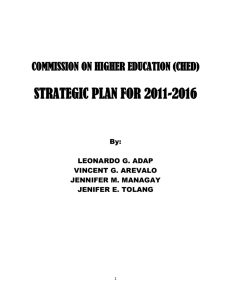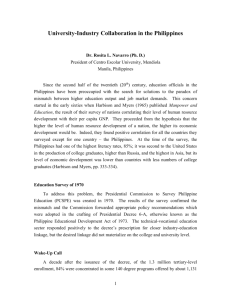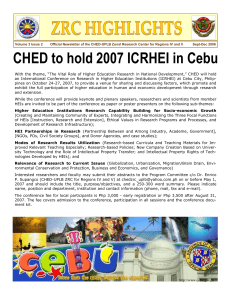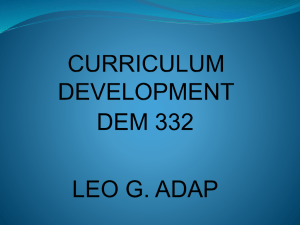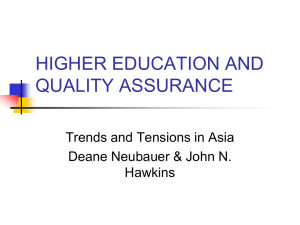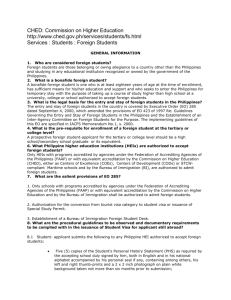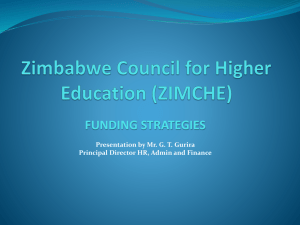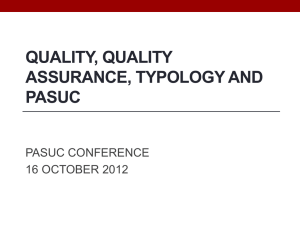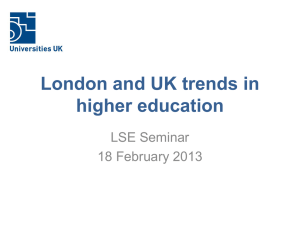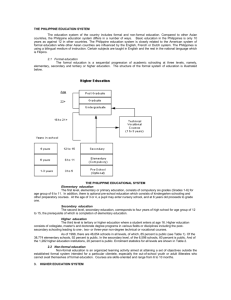Challenges in Higher Education
advertisement
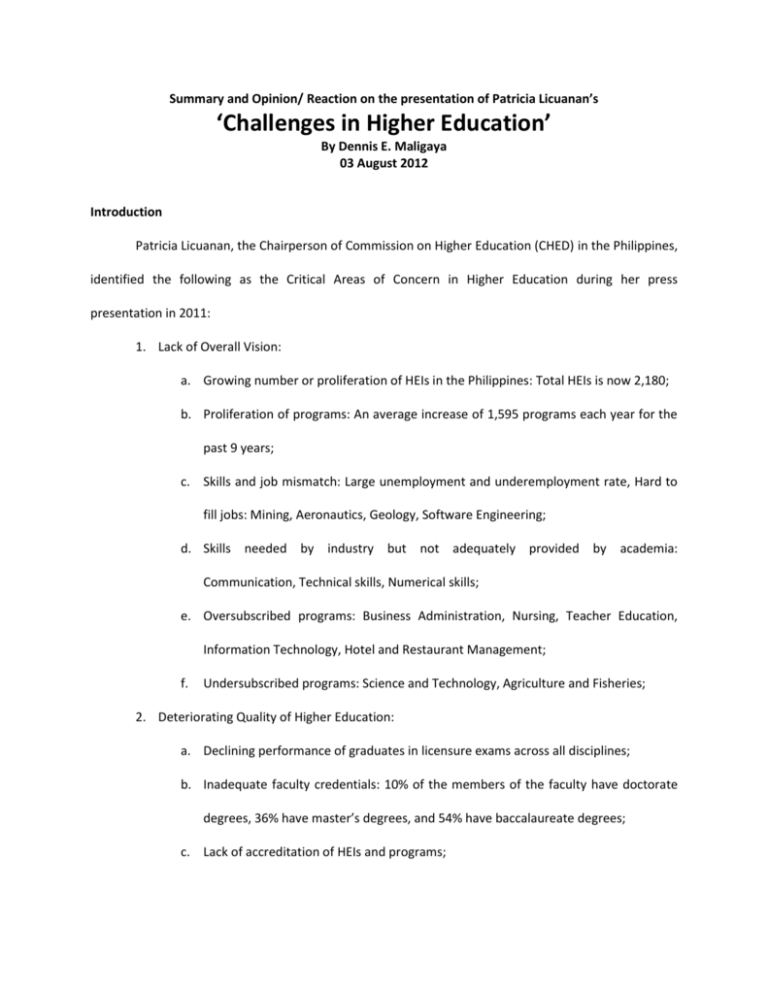
Summary and Opinion/ Reaction on the presentation of Patricia Licuanan’s ‘Challenges in Higher Education’ By Dennis E. Maligaya 03 August 2012 Introduction Patricia Licuanan, the Chairperson of Commission on Higher Education (CHED) in the Philippines, identified the following as the Critical Areas of Concern in Higher Education during her press presentation in 2011: 1. Lack of Overall Vision: a. Growing number or proliferation of HEIs in the Philippines: Total HEIs is now 2,180; b. Proliferation of programs: An average increase of 1,595 programs each year for the past 9 years; c. Skills and job mismatch: Large unemployment and underemployment rate, Hard to fill jobs: Mining, Aeronautics, Geology, Software Engineering; d. Skills needed by industry but not adequately provided by academia: Communication, Technical skills, Numerical skills; e. Oversubscribed programs: Business Administration, Nursing, Teacher Education, Information Technology, Hotel and Restaurant Management; f. Undersubscribed programs: Science and Technology, Agriculture and Fisheries; 2. Deteriorating Quality of Higher Education: a. Declining performance of graduates in licensure exams across all disciplines; b. Inadequate faculty credentials: 10% of the members of the faculty have doctorate degrees, 36% have master’s degrees, and 54% have baccalaureate degrees; c. Lack of accreditation of HEIs and programs; d. Inadequate facilities: Among the 1,792 HEIs, only 100 or 5.6% of HEIs can be assumed to have adequate facilities; e. Unplanned expansion: Increasing number of SUC satellite campuses, and Increasing programs beyond original mandate; f. Declining global competitiveness: World ranking of Philippine HEIs based on Quacquarelli Symonds (QS) and World University Rankings in 2010- 4 in the top 500 in 2006, and 3 in the top 500 in 2010; APEC Engineers Registry- 40 Filipino Engineers g. Low participation rate and completion rate: Out of 9.6 million 15-19-year olds, 21 % go to college; 3. Limited Access to Quality Education: a. Increasing Costs; b. Limited Student Assistance Programs; The following Key Result Areas were identified by Licuanan: a. Rationalization of Higher Education: 1. Aligning Higher Education with National Development Goals; 2. Developing Typology of HEIs; 3. Mapping of HEIs and Programs; 4. Amalgamation of HEIs; 5. Moratorium on New HEIs and Programs; 6. Harmonization of Public and Private HEIs (Leveling the Playing Field); 7. Rationalization of Credentials; b. Improving Quality and Standards: 1. Quality Assurance- IQuAME as developmental instrument for non-accredited HEIs; 2. Support for accreditation; 3. Rigorous and transparent systems for autonomous and deregulated HEIs centers of excellence and centers of development; 4. Improved and effective technical panels; 5. More developmental and less prescriptive Policies; 6. Standards and Guidelines (PSGs); 7. Improving Quality and Standards; 8. Expansion of Faculty Development; 9. Phase-out/Closure of Substandard Programs and Institutions; 10. Moratorium on New Programs; 11. Providing Development Support and Incentives to Deserving HEIs; 12. Aligning Philippine HEI Curricula and Standards with International Benchmarks. c. Increasing Access to Quality Higher Education: 1. Improve and Expand Government Assistance to Students and Teachers in Private Education (GASTPE); 2. Expand the Student Financial Assistance Program (STUFAP) through Scholarships, Grants-in-Aid, Study Now Pay Later Plan; 3. Alternative Learning Systems (ALS) through the Expanded Tertiary Education Equivalency and Accreditation Program (ETEEAP), Ladderized Education Program (LEP). The CHED has also identified the following factors in its quest to improve the internal environment of its organization through fostering a Policy Environment that has transparency and accountability, and improved overall organization. a. Transparency and Accountability: 1. Transparency of Systems and Processes; 2. Elimination of Corrupt and Questionable Practices in CHED; 3. Elimination of Corrupt and Questionable Practices in SUCs and all HEIs; 4. Recognition of CHED as a Clean and Honest Agency b. Organizational Development: 1. Development of Highly Skilled; 2. Professional and Motivated Human Resources at CHED; 3. Building of Partnerships and Linkages; 4. CHED as Relevant and Interested Actor in National and Global Issues; 5. Amendment to CHED Charter (RA7262); 6. CHED as a Modern, Technology-enabled Organization; 7. CHED Systems and Processes as Efficient and Effective Methodology Patricia Licuanan, the chairperson of the Commission on Higher Education presented in PowerPoint her so-called ‘Challenges in Higher Education’ before a press briefing in 2011. Results The Performance Indicators for the Key Result Areas (KRAs) mentioned above were not part of the presentation of Ms. Licuanan. The figures presented in the Introduction (see above) were statistics to critical factors in higher education as presented by Licuanan. Discussion A number of the findings of Licuanan’s study have already been identified by similar studies: Perlman (1978), and almost the same time with Licuanan is a study by the Asian Institute of Management (AIM) in 2011. Daniel H. Perlman (1978) identified the current problems facing higher education in the Philippines. They are (1) bilingualism (English and Filipino), (2) accreditation, (3) government regulations, (4) overproduction of graduates, (5) mismatch between graduates and needed skills, (6) imbalance between public and private schools, (7) over concentration of students in Manila, and (8) uncertain staff and physical plant standards. The Asian Institute of Management in 2011 identified the following as the Philippine Higher Education Challenges: 1. Access, 2. Retention, 3. Relevance, 4. Quality, 5. Equity. Following is an article by Dr. Flor Lacanilao for the Worldfolio on 03 August 2012 regarding a press briefing by Licuanan that expounds her prior presentation on the ‘Challenges to Higher Education. Viz: The Philippines is made up of a well-educated population that has traditionally put much emphasis on formal schooling; however, Dr. Patricia Licuanan, chairwoman of the Commission on Higher Education (CHED) believes in a more practical approach for the country and is not pressing the need for higher education for all Filipinos. “There has to be a shift in attitude so that we also respect and value technical and vocational education,” says Ms. Licuanan. “We are too white collar in our attitude. For the Millennium Development Goals, basic education is necessary.” CHED recognizes that the need for basic education is greater than that of higher education, and plans to use instruction, research and extension, to combat poverty with community and social development oriented approaches. She stresses that R&D is important for developing innovations that can change the quality of life for communities. “For instruction it may not be as clear but there are programs in higher education that cater to developing the lower sectors in society,” says Ms. Licuanan. “Not enough of our young people enter agriculture anymore and there is certainly not enough that go into science and technology. These are necessary and we think higher education does have a role.” She aims to clean up corruption and improve technology and service quality to make CHED a more effective component in the government machine. “This is really our challenge for higher education: to work with the really good basic ingredients we have and just straighten up the parts that need it and bring in some technology inputs in strategic areas that we aim to develop,” she says. CHED is looking beyond Filipino borders to aid in development by focusing on the inclusion of successful people abroad to start projects and become mentors. She aims to show the world the potential of the country as it takes steps to achieve a noticeable amount of change. “I’d like them to see the Philippines truly as an exciting and positive place to be for foreigners and Filipinos,” says CHED’s chairwoman. “I may be biased but Filipinos are very creative and intelligent people and once we set our minds to something we can achieve so much.” Producing a bigger workforce and putting in more money have been the usual answers of the Philippine government to address the poor state of its science and education. An analysis of the situation, however, does not point to the size of the workforce and lack of funding as the major causes of this problem. It is the government’s failure to attend to the real causes of the problem that has led to the continued deterioration of our S&T and education situation. To begin with, consider the predicament of the National Science Consortium, which has been put up by the country’s seven top universities and the Department of Science and Technology’s Science Education Institute to pursue the following objectives: (1) “enhance the capability of the Philippine higher education system to produce technically competent PhD and MS graduates” and (2) “address the persistent lack of Filipino scientists and researchers, who would enable our country to compete economically with its neighbors.” These objectives are actually similar to those of past programs that had failed. Now, the Consortium gives figures that put our 2009 researcher population density at 1 per 12,300 persons, which was far below that of Singapore at 1 per 164. This means that the Philippines had 7,500 researchers against tiny Singapore’s 28,000. With these benchmarks in mind, the Science Consortium aims to produce 250 PhD and 350 MS graduates per year. But the big question remains: Will this solve the problems of Philippine science and higher education? Last year, at the international conference in Japan on teaching and research activities, a report of scientific publications of 10 Asian countries showed the Philippines with the least published papers. The Philippines had only 178 valid publications in 2005, whereas Singapore had 3,609, or 20 times more. Since Singapore’s 28,000 researchers were 4 times that of the Philippines’ 7,500, and Singapore’s research output was 3,609 against our 128, then Singapore researchers were 5 times more productive than their Philippine counterparts. How did this happen? Failed programs Data in the last three decades show that although the number of researchers in the Philippines has been increasing, publications per PhD even decreased; indeed, the national output hardly increased. A lot of the research funds went to unpublished or poorly published researchers who produced unpublished or improperly published papers—in short, gray literature. Gray literature is not taken seriously, of course, and it doesn’t count in international evaluations of research performance, as the above-cited study of publications in 10 Asian countries shows. At UP Diliman’s College of Science, which is the country’s best, a reform program in 1983 had aimed at increasing the PhDs in the faculty. It succeeded in doubling the number to over 90 PhDs in 10 years. But the number of properly published papers decreased. It dropped from 24 to 15 percent of total publications, or from only 12 to 5 percent of the papers produced per PhD (See Celebrating the UP Centennial, Table 1). This means that for every 20 papers, only 1 counted in international evaluations of S&T performance. Further, the DOST launched the Science and Technology Master Plan in 1990-2000. Its R&D budget had increased yearly in 1991-1995, a fourfold growth from P800 million to over P3 billion. In 19921998, it implemented the Engineering and Science Education Project (ESEP) with funding from the World Bank. This was to upgrade engineering and science through PhD and MS scholarships. “If one surveys local universities today, one will find that many of the leaders were ESEP graduates,” a report said. Yet with all the money, effort, and years spent on those programs, the country's S&T hardly improved. The research output remained the same from 1981 to 1995. And the total of Philippine publications in leading journals even decreased in 2000 to 2005—from a mere 185 down to 178, according to the above-cited study of scientific publications in Asia. The figures show that although the country’s researchers have increased to 7,500 during the past three decades, the total research output has even gotten worse; it increased in quantity but decreased in quality. Hence, the programs largely succeeded only in increasing the number of poor mentors and decreasing the general quality of graduates. There are 764 PhD faculty members from our top universities that are involved in the Consortium program. Note that although they produced all of the country's 178 publications, their research productivity is only 0.23 per PhD. This is far below that of the Faculty of Science at the National University of Singapore, where its 154 PhDs produced 389 publications in 1994, or 2.5 per PhD, which is more than 10 times than the output of our best graduate faculties. (The world-class standard is 1 per PhD per year.) Ours can hardly be expected to properly mentor the projected 250 PhD and 350 MS graduates yearly, so how can we ever catch up with our neighbor countries that have left us behind? The failed programs cited above have been the main reasons for the stunted growth of Philippine science and education. And the major culprit is the persistent practice of peer review or personal judgment by unpublished and poorly published officials and faculty members, who are the ones evaluating research proposals and publications, screening faculty applicants, and giving promotions, recognitions, and awards. Effective systems In contrast, objective and internationally accepted criteria for performance evaluation have been successful. When implemented with cash rewards for outstanding publications, these criteria greatly increased useful research output (See Renaissance section of “Celebrating the UP Centennial”). At the UP, where a PhP50,000 reward is given per published paper in an international journal, publications increased from 25 to 40 percent of the national total between 1997-99 and 2002. (The combined publication output of La Salle, Ateneo, UST, and San Carlos during the same period increased from only 7.8 to 8.0 percent of the national total; the rest was largely produced by IRRI in Los Baños.) At SEAFDEC in Iloilo, which offered a cash incentive of 50% of annual salary, publications of the 50 research staff—only 9 of them were PhDs—increased sevenfold in 1993 after only 6 years. In fast-developing countries like China and Brazil, other forms of incentives have significantly increased international journal publications. The results of the above programs show that the stunted growth of science in the Philippines is rooted more in wrong research practices than in lack of researchers and funds, either of which is the convenient excuse given by many for their poor research output or outright failure to do research. With an incentive system that uses objective, internationally accepted criteria, however, it would be possible for the Philippines to produce the desired R&D output, save on research funds, justify even higher R&D budgets, and find a viable way to really reforming its science and higher education. The National Science Consortium should therefore seriously consider granting research incentives, allotting a substantial portion of its program funds for rewards to properly publish papers and providing support for the proposals of published proponents. Because its performance indicators are objective, the incentive system can minimize personal judgment of research proposals and publications by nonscientists, fix the other wrong research practices, allow fruitful use of development funds, improve the performance of the 7,500 researchers, and produce better-qualified teachers and mentors for undergraduate and graduate students. For its part, the Commission of Higher Education (CHED) should do away with putting up research journals; instead, it should encourage researchers to publish in SCI-indexed journals. CHED is supporting 190 state universities and colleges where only 10 percent of the faculty members have PhD degrees. Worse yet, how many of them are published? How can they manage research journals or review manuscripts when hardly any one of them is qualified to do so? In fact, not a single Philippine journal in science to date has met the criteria for SCI coverage. Further, it is commonly thought that it is more important to improve basic education than higher education, when experience shows it should really be the other way around—higher education first, basic educations second. As Carl Wieman, Nobel laureate in physics, has observed, it is doubtful that great progress can be made at the primary and secondary levels to a higher standard of science learning is set in the post-secondary level. In sum, the Philippines should radically reform its approaches to ensure the achievement of the objectives of the National Science Consortium and to give itself a sporting chance of catching up with its more progressive neighboring countries in the science and technology arena.
